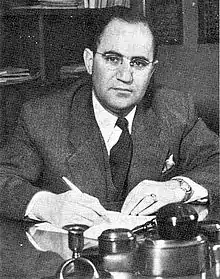Jahanshah Saleh | |
|---|---|
 | |
| Minister of Health | |
| In office 1950 – March 1951 | |
| Monarch | Mohammad Reza Pahlavi |
| Prime Minister | |
| Preceded by | Mohammad Ali Varasteh |
| Personal details | |
| Born | 1905 Kashan, Qajar Iran |
| Died | 1995 (aged 89–90) Tehran, Iran |
| Alma mater | |
| Occupation | Physician |
Jahanshah Saleh (1905–1995) was an Iranian physician and politician. He served as health minister and education minister in the 1950s and 1960s. He was the obstetrician of Queen Farah Diba, spouse of Shah Mohammad Reza Pahlavi.
Early life and education
Saleh was born in Kashan in 1905.[1] He obtained a degree in obstetrics and gynecology from Columbia University, the US.[2] He received further education at Syracuse University in the USA on gynecology.[3][4] He graduated from the university in 1934 and returned to Iran.[3]
Career
Saleh worked at the faculty of medicine in Tehran and was promoted to the title of associate professor.[3] Later he became professor of gynecology.[1] In 1936 he was appointed instructional head of the newly founded nursing school in Tehran.[5] He headed the surgery department of women at Vaziri Hospital and also headed the midwifery school.[3] He also worked at the Women's Hospital which was later renamed Jahanshah Saleh Hospital.[3] In 1948 Saleh was appointed dean of the faculty of medicine at the University of Tehran.[6]
Saleh was the health minister in the cabinet led by Haj Ali Razmara in the period 1950–1951.[6][7] He replaced Mohammad Ali Varasteh in the post.[8] Saleh remained in office in the next cabinet formed by Hossein Ala'.[1] In the cabinet formed by Fazlollah Zahedi after the 1953 coup against Prime Minister Mohammad Mosaddegh Saleh was also appointed minister of health in August 1953.[9]
Saleh served as the obstetrician of Farah Pahlavi.[10] He accompanied her during the birth of Prince Reza Cyrus Pahlavi in 1960.[10] Saleh was appointed minister of education in the cabinet formed by Jafar Sharif-Emami in March 1961.[11] In 1966 he was serving as the president of the University of Tehran.[3]
Later years and death
Saleh was not only interested in medicine, but also in environmental protection.[12] He was one of the Iranians who reported concerns over the quality of air in the cities.[12] Initially his views were not taken into consideration, but in 1963 the Supreme Council of City Safety stated that air in the capital city, Tehran, was not healthy.[3] Saleh died in Tehran in 1995.[1]
References
- 1 2 3 4 "جهانشاه صالح به روایت اسناد لانه جاسوسی" (in Persian). Political Studies and Research Institute. Retrieved 6 November 2022.
- ↑ Mohammad Hossein Azizi; et al. (October 2013). "History of Cancer in Iran". Archives of Iranian Medicine. 16 (10): 615. PMID 24093147.
- 1 2 3 4 5 6 7 A. Karimian (2017). "A Survey on History the First Women's Hospital in Iran". SJMR. 2 (2): 117–126. doi:10.29252/sjrm.1.3.117. S2CID 249185185.
- ↑ "Iran rejoices as Shah gets a son at least". St. Petersburg Times. Tehran. Associated Press. 1 November 1960. Retrieved 27 April 2022.
- ↑ Firoozeh Kashani-Sabet (February 2006). "The Politics of Reproduction: Maternalism and Women's Hygiene in Iran, 1896-1941". International Journal of Middle East Studies. 38 (1): 12. doi:10.1017/S002074380641223X. S2CID 162569581.
- 1 2 Moslem Bahadori; Mohammad-Hossein Azizi (July 2007). "The First Medical Journal of Tehran University". Archives of Iranian Medicine. 10 (3): 422. PMID 17604489.
- ↑ "Developments of the Quarter: Comment and Chronology". The Middle East Journal. 4 (4): 471. October 1950. JSTOR 4322222.
- ↑ Mohammad Hossein Azizi (2007). "The Historical Backgrounds of the Ministry of Health Foundation in Iran". Archives of Iranian Medicine. 10 (1): 123. PMID 17198470.
- ↑ Kennett Love (24 August 1953). "Shah reports Iran needs aid at once". The New York Times. Tehran. p. 6. ProQuest 112600919. Retrieved 24 May 2023.
- 1 2 "Iran: An Heir at Last". Time Magazine. 14 November 1960. Retrieved 27 April 2022.
- ↑ "Sharif-Imami picks new Iran cabinet". The New York Times. Tehran. Reuters. 12 March 1961. p. 9. ProQuest 115212277. Retrieved 24 May 2023.
- 1 2 Ciruce Movahedi-Lankarani (2022). "A Ghoul at the Gates: Natural Gas Energy and the Environment in Pahlavi Iran, 1960–1979". International Journal of Middle East Studies. 54 (1): 87. doi:10.1017/S002074382100132X. S2CID 247585068.